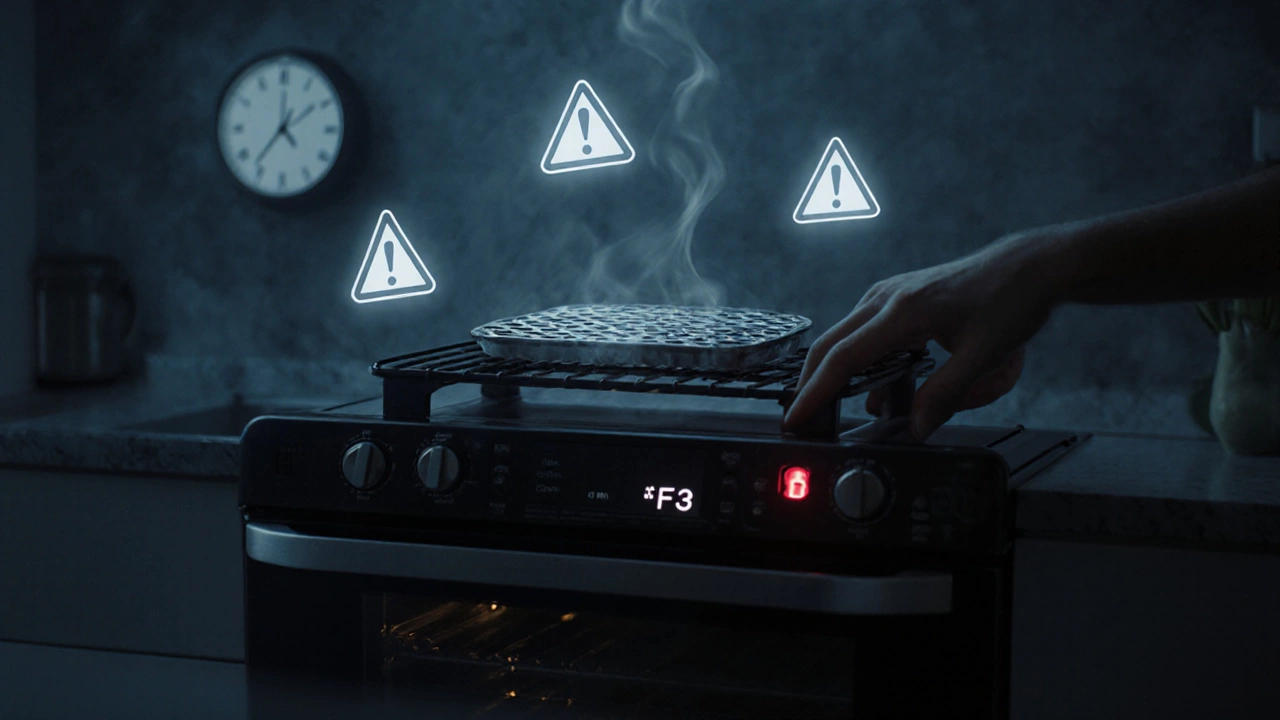
- 17 Nov 2025
- Gideon Thornton
- 0
Oven Safety Checker
Assess Your Oven Safety
This tool evaluates the safety risks of using your oven with a broken heating element based on your specific situation. Never use a damaged oven without proper assessment.
Oven Safety Assessment
Safety Assessment Results
Safety Summary
Recommendations
Repair Costs
If your electric oven isn’t heating up, the first thing you check is the heating element. And if it’s visibly broken-cracked, burnt, or sagging-you’re probably wondering: can I still use my oven if the heating element is broken?
The short answer? No. Not safely, not reliably, and not for anything that actually needs heat.
Some people think they can still use the oven for things like broiling, or using the grill, or even just leaving the door open to warm the kitchen. That’s dangerous thinking. And here’s why.
Why a Broken Heating Element Makes Your Oven Unsafe
The heating element in your oven isn’t just a coil that glows red. It’s part of a closed electrical circuit designed to deliver precise, controlled heat. When it breaks, it doesn’t just stop working-it can expose live wires, create arcing, or cause electrical shorts inside the cavity.
In the UK, most electric ovens run on 240V. A broken element can leave metal fragments or exposed terminals energized. If moisture from cleaning, steam from cooking, or even condensation gets near those spots, you risk a short circuit. That can trip your breaker, fry your control board, or worse-start a fire.
There are real cases from the UK Fire and Rescue Service where faulty oven elements led to kitchen fires. One in Bristol in 2024 started because a cracked element sparked when the oven was turned on, igniting grease buildup inside the cavity. No one was hurt, but the oven and cabinetry were destroyed.
What Happens When You Try to Use It Anyway?
You might think: “It still turns on. The light works. The fan spins. So why can’t I just use it?”
Here’s what actually happens:
- The oven’s thermostat still thinks it’s heating, so it keeps trying to activate the broken element.
- Without a working element, the oven never reaches temperature-so your food stays cold or undercooked.
- Any attempt to bake, roast, or even preheat becomes useless. You’re just wasting electricity.
- Some models will flash error codes like “F3” or “E0,” but others just silently fail, making you think you’re doing something wrong with the recipe.
And if you’ve got a fan-assisted oven, you might notice the fan running while the oven stays cold. That’s normal. The fan isn’t the heater. It’s just moving air. Without the element, it’s just a noisy fan in a metal box.
Can I Use the Grill or Broil Function?
Some ovens have a separate grill element at the top. If that’s still working, you might be tempted to use just the grill. But here’s the catch: most modern ovens are wired so that the main heating element and the grill share the same control circuit. If the main element is broken, it can interfere with the grill’s operation-even if the grill element looks fine.
Try this: Turn on the grill function and watch the top element. If it doesn’t glow red within 30 seconds, it’s likely not getting power because the control board has shut down the whole circuit due to the fault.
Even if the grill does work, don’t assume it’s safe. A broken main element can cause voltage imbalances that stress other components. You’re playing Russian roulette with your appliance.
What About Using the Oven for Non-Cooking Tasks?
Some people try to repurpose a broken oven: warming plates, drying herbs, even heating the kitchen. Don’t.
Electric ovens aren’t space heaters. They’re designed to contain heat in a controlled environment. A broken element can overheat nearby wiring, insulation, or plastic components inside the oven casing. That heat can melt insulation, cause smoke, or ignite dust and grease trapped behind the panels.
In 2023, a homeowner in Manchester left their oven on overnight to “warm the room” after the element failed. The faulty wiring sparked behind the control panel. The fire spread to the kitchen cabinets before the smoke alarm woke them. The oven was a total loss.

How to Confirm the Heating Element Is Broken
Before you assume the element is dead, check properly:
- Turn off the power at the circuit breaker.
- Remove the oven racks and any panels covering the element.
- Look closely: Is the element discoloured, bulging, or broken in two? Any visible gaps or blackened spots? That’s a clear sign.
- Use a multimeter to test for continuity. Set it to ohms (Ω). Touch one probe to each terminal on the element. If it reads zero or infinite resistance, it’s dead. A good element should read between 20 and 120 ohms.
- If you’re not comfortable with a multimeter, don’t guess. Call a professional.
Don’t rely on visual inspection alone. Sometimes an element looks fine but is internally cracked. Only a multimeter gives you certainty.
How Much Does It Cost to Replace the Element?
Replacing a heating element is one of the cheapest oven repairs you can do.
- Element itself: £25-£60, depending on your oven model.
- Labour (if you hire someone): £60-£120, usually under an hour’s work.
- DIY: If you’re handy, you can do it yourself in 30 minutes with a screwdriver and a new element.
Many brands like Hotpoint, Indesit, and Belling use standard elements. You can find the right part by searching your oven’s model number on sites like eBay, Amazon, or appliance parts specialists like Espares or RepairCare.
Don’t buy generic “universal” elements unless they’re listed as compatible with your exact model. Mismatched elements can overheat, fail faster, or damage your control board.
When to Replace the Whole Oven
Is it worth repairing? That depends.
If your oven is under five years old and you’ve had no other issues, replacing the element is a no-brainer. Even if it’s 10 years old, it’s often still worth fixing-unless you’ve got multiple failing parts.
But if you’re dealing with:
- Repeated element failures
- Control board errors
- Uneven heating across multiple zones
- High energy bills despite normal use
Then it might be time to think about a new oven. A new built-in electric oven in the UK starts around £400, but energy-efficient models with better insulation can save you £50-£80 a year on bills.

What to Do Right Now
If your element is broken:
- Turn off the oven at the wall socket or circuit breaker.
- Don’t use it for anything-not even to warm plates.
- Check your warranty. Some brands offer 2-5 year parts coverage.
- Order the replacement element using your model number.
- If you’re not confident with tools, book a repair with a Gas Safe registered engineer (yes, even for electric ovens-they’re trained on all appliances).
Waiting won’t make it better. The longer you delay, the more likely you are to damage the thermostat, control board, or even the wiring in your kitchen wall.
Preventing Future Breakdowns
Heating elements don’t just break randomly. They wear out because of:
- Spills and moisture left inside the oven
- Using abrasive cleaners that scratch the element coating
- Overloading the oven with heavy trays that touch the element
- Running the self-clean cycle too often (it superheats the element beyond normal limits)
Simple fixes: wipe spills right away. Use vinegar and baking soda instead of harsh oven cleaners. Never let pots or pans touch the element. And skip the self-clean function unless you really need it.
Most elements last 5-10 years. With good care, yours could last longer.
Final Thought: It’s Not Worth the Risk
Yes, your oven still turns on. Yes, the light still works. But a broken heating element isn’t a minor glitch. It’s a hidden electrical hazard. You’re not saving money by ignoring it-you’re risking your home, your safety, and your wallet.
Replacing the element is cheap, fast, and easy. Waiting? That’s when things go wrong.
Can I use my oven if the heating element is broken?
No. A broken heating element makes your oven unsafe to use. Even if other parts like the light or fan still work, the exposed wiring or electrical faults can cause shocks, short circuits, or fires. Never use an oven with a damaged element.
Why won’t my oven heat up even though the element looks fine?
Sometimes the element looks intact but is internally cracked. Use a multimeter to test for continuity. If it reads zero or infinite resistance, it’s broken. Other causes could be a faulty thermostat, control board, or wiring issue.
How much does it cost to replace an oven heating element?
The element itself costs £25-£60. Professional installation adds £60-£120. DIY replacement is possible with basic tools and takes under 30 minutes if you follow your oven’s manual.
Can I use the grill if the main element is broken?
Sometimes, but not reliably. Many ovens share circuits between the main element and grill. A broken main element can prevent the grill from working, or cause electrical stress that damages the grill. Test it carefully, but don’t rely on it.
Is it worth repairing an old oven with a broken element?
Yes-if your oven is under 10 years old and has no other major issues. Replacing the element is usually cheaper than buying a new oven. But if you’re facing multiple repairs, or your oven is inefficient, it may be time to upgrade.




